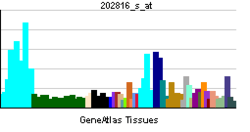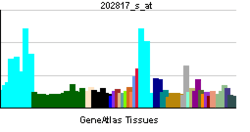SS18
| Synovial sarcoma translocation, chromosome 18 | |||||||||||||
|---|---|---|---|---|---|---|---|---|---|---|---|---|---|
| Identifiers | |||||||||||||
| Symbols | SS18 ; SSXT; SYT | ||||||||||||
| External IDs | OMIM: 600192 MGI: 107708 HomoloGene: 38080 GeneCards: SS18 Gene | ||||||||||||
| |||||||||||||
| RNA expression pattern | |||||||||||||
 | |||||||||||||
 | |||||||||||||
 | |||||||||||||
| More reference expression data | |||||||||||||
| Orthologs | |||||||||||||
| Species | Human | Mouse | |||||||||||
| Entrez | 6760 | 268996 | |||||||||||
| Ensembl | ENSG00000141380 | ENSMUSG00000037013 | |||||||||||
| UniProt | Q15532 | Q62280 | |||||||||||
| RefSeq (mRNA) | NM_001007559 | NM_001161369 | |||||||||||
| RefSeq (protein) | NP_001007560 | NP_001154841 | |||||||||||
| Location (UCSC) | Chr 18: 23.6 – 23.67 Mb | Chr 18: 14.62 – 14.68 Mb | |||||||||||
| PubMed search | |||||||||||||
Protein SSXT is a protein that in humans is encoded by the SS18 gene.[1][2][3]
Function
SS18 is a member of the human SWI/SNF chromatin remodeling complex.[4][5][6]
Clinical significance
SS18 is involved in a chromosomal translocation commonly found in synovial sarcoma.[7]
Interactions
SS18 has been shown to interact with:
References
- ↑ Shipley JM, Clark J, Crew AJ, Birdsall S, Rocques PJ, Gill S, Chelly J, Monaco AP, Abe S, Gusterson BA (May 1994). "The t(X;18)(p11.2;q11.2) translocation found in human synovial sarcomas involves two distinct loci on the X chromosome". Oncogene 9 (5): 1447–53. PMID 8152806.
- ↑ Clark J, Rocques PJ, Crew AJ, Gill S, Shipley J, Chan AM, Gusterson BA, Cooper CS (Dec 1994). "Identification of novel genes, SYT and SSX, involved in the t(X;18)(p11.2;q11.2) translocation found in human synovial sarcoma". Nat Genet 7 (4): 502–8. doi:10.1038/ng0894-502. PMID 7951320.
- ↑ de Bruijn DR, Geurts van Kessel A (2006). "Common origin of the human synovial sarcoma associated SS18 and SS18L1 gene loci". Cytogenet. Genome Res. 112 (3-4): 222–6. doi:10.1159/000089874. PMID 16484776.
- ↑ Middeljans E, Wan X, Jansen PW, Sharma V, Stunnenberg HG, Logie C (2012). "SS18 together with animal-specific factors defines human BAF-type SWI/SNF complexes". PLoS ONE 7 (3): e33834. doi:10.1371/journal.pone.0033834. PMC 3307773. PMID 22442726.
- ↑ 5.0 5.1 Kato H, Tjernberg A, Zhang W, Krutchinsky AN, An W, Takeuchi T, Ohtsuki Y, Sugano S, de Bruijn DR, Chait BT, Roeder RG (2002). "SYT associates with human SNF/SWI complexes and the C-terminal region of its fusion partner SSX1 targets histones". J. Biol. Chem. 277 (7): 5498–505. doi:10.1074/jbc.M108702200. PMID 11734557.
- ↑ 6.0 6.1 Perani M, Ingram CJ, Cooper CS, Garrett MD, Goodwin GH (2003). "Conserved SNH domain of the proto-oncoprotein SYT interacts with components of the human chromatin remodelling complexes, while the QPGY repeat domain forms homo-oligomers". Oncogene 22 (50): 8156–67. doi:10.1038/sj.onc.1207031. PMID 14603256.
- ↑ Yang K, Lui WO, Xie Y, Zhang A, Skytting B, Mandahl N, Larsson C, Larsson O (June 2002). "Co-existence of SYT-SSX1 and SYT-SSX2 fusions in synovial sarcomas". Oncogene 21 (26): 4181–90. doi:10.1038/sj.onc.1205569. PMID 12037676.
- ↑ Eid JE, Kung AL, Scully R, Livingston DM (2000). "p300 interacts with the nuclear proto-oncoprotein SYT as part of the active control of cell adhesion". Cell 102 (6): 839–48. doi:10.1016/S0092-8674(00)00072-6. PMID 11030627.
- ↑ de Bruijn DR, dos Santos NR, Thijssen J, Balemans M, Debernardi S, Linder B, Young BD, Geurts van Kessel A (2001). "The synovial sarcoma associated protein SYT interacts with the acute leukemia associated protein AF10". Oncogene 20 (25): 3281–9. doi:10.1038/sj.onc.1204419. PMID 11423977.
Further reading
- Fligman I; Lonardo F; Jhanwar SC et al. (1996). "Molecular diagnosis of synovial sarcoma and characterization of a variant SYT-SSX2 fusion transcript". Am. J. Pathol. 147 (6): 1592–9. PMC 1869933. PMID 7495284.
- Brett D; Whitehouse S; Antonson P et al. (1998). "The SYT protein involved in the t(X;18) synovial sarcoma translocation is a transcriptional activator localised in nuclear bodies". Hum. Mol. Genet. 6 (9): 1559–64. doi:10.1093/hmg/6.9.1559. PMID 9285794.
- Thaete C; Brett D; Monaghan P et al. (1999). "Functional domains of the SYT and SYT-SSX synovial sarcoma translocation proteins and co-localization with the SNF protein BRM in the nucleus". Hum. Mol. Genet. 8 (4): 585–91. doi:10.1093/hmg/8.4.585. PMID 10072425.
- Eid JE, Kung AL, Scully R, Livingston DM (2000). "p300 interacts with the nuclear proto-oncoprotein SYT as part of the active control of cell adhesion". Cell 102 (6): 839–48. doi:10.1016/S0092-8674(00)00072-6. PMID 11030627.
- Tamborini E; Agus V; Mezzelani A et al. (2001). "Identification of a novel spliced variant of the SYT gene expressed in normal tissues and in synovial sarcoma". Br. J. Cancer 84 (8): 1087–94. doi:10.1054/bjoc.2000.1710. PMC 2363857. PMID 11308259.
- Brodin B; Haslam K; Yang K et al. (2001). "Cloning and characterization of spliced fusion transcript variants of synovial sarcoma: SYT/SSX4, SYT/SSX4v, and SYT/SSX2v. Possible regulatory role of the fusion gene product in wild type SYT expression". Gene 268 (1–2): 173–82. doi:10.1016/S0378-1119(01)00412-7. PMID 11368913.
- de Bruijn DR; dos Santos NR; Thijssen J et al. (2001). "The synovial sarcoma associated protein SYT interacts with the acute leukemia associated protein AF10". Oncogene 20 (25): 3281–9. doi:10.1038/sj.onc.1204419. PMID 11423977.
- Suzuki H; Fukunishi Y; Kagawa I et al. (2001). "Protein–Protein Interaction Panel Using Mouse Full-Length cDNAs". Genome Res. 11 (10): 1758–65. doi:10.1101/gr.180101. PMC 311163. PMID 11591653.
- Kato H; Tjernberg A; Zhang W et al. (2002). "SYT associates with human SNF/SWI complexes and the C-terminal region of its fusion partner SSX1 targets histones". J. Biol. Chem. 277 (7): 5498–505. doi:10.1074/jbc.M108702200. PMID 11734557.
- Yang K; Lui WO; Xie Y et al. (2002). "Co-existence of SYT-SSX1 and SYT-SSX2 fusions in synovial sarcomas". Oncogene 21 (26): 4181–90. doi:10.1038/sj.onc.1205569. PMID 12037676.
- Strausberg RL; Feingold EA; Grouse LH et al. (2003). "Generation and initial analysis of more than 15,000 full-length human and mouse cDNA sequences". Proc. Natl. Acad. Sci. U.S.A. 99 (26): 16899–903. doi:10.1073/pnas.242603899. PMC 139241. PMID 12477932.
- Imabayashi H; Mori T; Gojo S et al. (2003). "Redifferentiation of dedifferentiated chondrocytes and chondrogenesis of human bone marrow stromal cells via chondrosphere formation with expression profiling by large-scale cDNA analysis". Exp. Cell Res. 288 (1): 35–50. doi:10.1016/S0014-4827(03)00130-7. PMID 12878157.
- Perani M; Ingram CJ; Cooper CS et al. (2003). "Conserved SNH domain of the proto-oncoprotein SYT interacts with components of the human chromatin remodelling complexes, while the QPGY repeat domain forms homo-oligomers". Oncogene 22 (50): 8156–67. doi:10.1038/sj.onc.1207031. PMID 14603256.
- Gerhard DS; Wagner L; Feingold EA et al. (2004). "The Status, Quality, and Expansion of the NIH Full-Length cDNA Project: The Mammalian Gene Collection (MGC)". Genome Res. 14 (10B): 2121–7. doi:10.1101/gr.2596504. PMC 528928. PMID 15489334.
- Iwasaki T, Koibuchi N, Chin WW (2005). "Synovial sarcoma translocation (SYT) encodes a nuclear receptor coactivator". Endocrinology 146 (9): 3892–9. doi:10.1210/en.2004-1513. PMID 15919756.
- Fernebro J; Francis P; Edén P et al. (2006). "Gene expression profiles relate to SS18/SSX fusion type in synovial sarcoma". Int. J. Cancer 118 (5): 1165–72. doi:10.1002/ijc.21475. PMID 16152617.
- Perani M; Antonson P; Hamoudi R et al. (2006). "The proto-oncoprotein SYT interacts with SYT-interacting protein/co-activator activator (SIP/CoAA), a human nuclear receptor co-activator with similarity to EWS and TLS/FUS family of proteins". J. Biol. Chem. 280 (52): 42863–76. doi:10.1074/jbc.M502963200. PMID 16227627.
- Sun Y; Gao D; Liu Y et al. (2006). "IGF2 is critical for tumorigenesis by synovial sarcoma oncoprotein SYT-SSX1". Oncogene 25 (7): 1042–52. doi:10.1038/sj.onc.1209143. PMID 16247461.